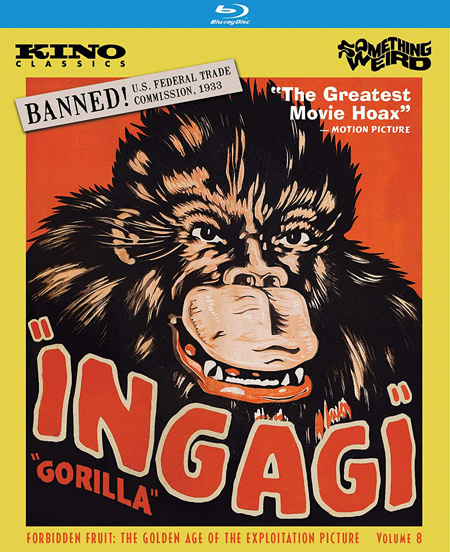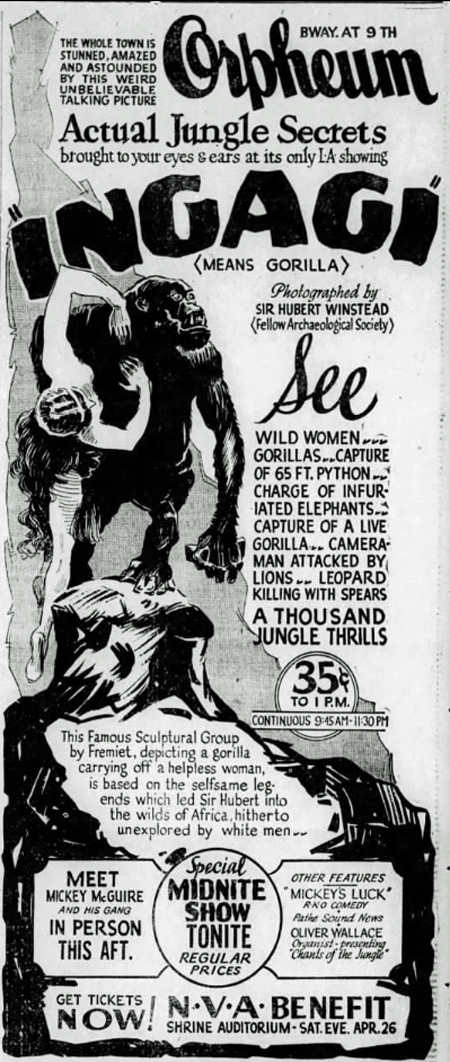
“ANOTHER
‘FORBIDDEN FRUIT’ EXPLOITATION RELICâ€
By
Raymond Benson
Here’s
another one, folks! Another entry in the “Forbidden Fruit: The Golden Age of
the Exploitation Picture†series, this time it’s Volume 8. Presented by Kino
Lorber in association with Something Weird Video, we have for your pleasure the
controversial “hoax†documentary, Ingagi (1930), a shocking example of
racism and circus sideshow-style cinematic exhibition.
There
have always existed what have been termed in the motion picture industry
“exploitation films,†even back in the silent days. The 1930s and much of the
1940s, however, saw a deluge of cheap, not-even-“B†pictures made, usually
independently of Hollywood and marketed in guerilla fashion as “educationalâ€
adult fare. You know the type. Reefer Madness. Child Bride. Mom
and Dad (all previous titles released in the Forbidden Fruit series).
Kino
Lorber and Something Weird have been doing a bang-up job on releasing some of
the best (i.e., infamous) of these jaw-dropping pieces of celluloid. Most are so
bad that they’re hilariously entertaining, and they especially elicit eye-rolling
because they often portend to be “instructive†in nature.
Ingagi
was marketed
as a documentary, which, by definition, claims to be a truthful depiction of
real events. Well, a gullible American audience of the year 1930 actually swallowed
this carnival act, because the independently made and distributed picture
grossed $4 million—and in 1930 dollars, that was a monstrous amount of
cash. The movie, however, was attacked by the Motion Picture Producers and
Distributors Association, a Hollywood organization that attempted to ban the
film. There were indeed court cases, but it was the Federal Trade Commission
that finally forced the production company, Congo Pictures, to either come
clean and stop duping the public with assertations that what the movie contains
is real—or withdraw it from exhibition. As a result, Ingagi disappeared
for years until it was bought and resold a couple of times and finally ended up
in the hands of Dwain Esper. Esper, one of the foremost practitioners of the
exploitation film, redistributed Ingagi in the late 1940s as the
scandalous and sensational movie it is… and the thing continued to make money. Ingagi
eventually vanished again for decades… until now.
It’s allegedly the footage of an
African exhibition led by “Sir Hubert Winstead.†The explorer and his team go
on safari and hunt and kill exotic animals for 3/4 of the picture. If that
wasn’t disgusting enough, the final quarter is about the “discovery†of a
primitive race that worships ingagi (the Rwandan word for “gorillaâ€).
The tribe sacrifices a woman every year to the ingagi, who mate with the human
females to produce, uhm, half-human/half-gorilla creatures.
Right.
Now you know why the film was banned.
When
one excavates the production history of the film, we learn that the whole thing
was a hoax to cheat the American moviegoer out of an admission fee. According
to both Kelly Robinson and Bret Wood, narrators on two separate audio
commentary tracks, 3/4 of the movie is actually stolen material from a 1915
silent movie, Heart of Africa, which documented a real safari—but for
some reason that picture was never even completed and is lost. That existing
footage, however, was hijacked by “Congo Pictures.†The remaining 1/4 of the
movie was shot in Hollywood with actors. African-Americans were cast as
stereotypical Tarzan-style natives, and men in gorilla suits portrayed the
apes. The lead ingagi is played by Charles Gemora, arguably the most
prolifically employed actor in a gorilla suit.

One
major clue to the lack of authenticity is that the narrator of the picture, the
supposed Sir Hubert Winstead, mispronounces ingagi throughout the movie.
He pronounces the middle syllable vowel of the word as “gag,†whereas it’s
supposed to be pronounced like “gog.â€
As
commentator Robinson tells us, the real appeal of going to see Ingagi was
to view “gorilla sex,†i.e., naked “native women†who are about to have sex
with gorillas. We don’t ever see that happen, but it’s implied. We do see
naked “native women,†and that’s where the picture gets its exploitation and
racist reputation.
Kino
Lorber’s high-definition presentation of this relic is amazingly good. A
featurette in the supplements details the restoration process that was
undertaken. The only other supplements are the interesting and informed audio
commentaries by Robinson and Wood, and trailers for other titles in the series.
Ingagi
will
appeal to fans of the Something Weird series, exploitation films, and cinema
curiosities. Hey, it’s “movie historyâ€â€”in fact, a print of Ingagi resides
in the Library of Congress as a testament to its infamous standing. Ungawa!
CLICK HERE TO ORDER FROM AMAZON